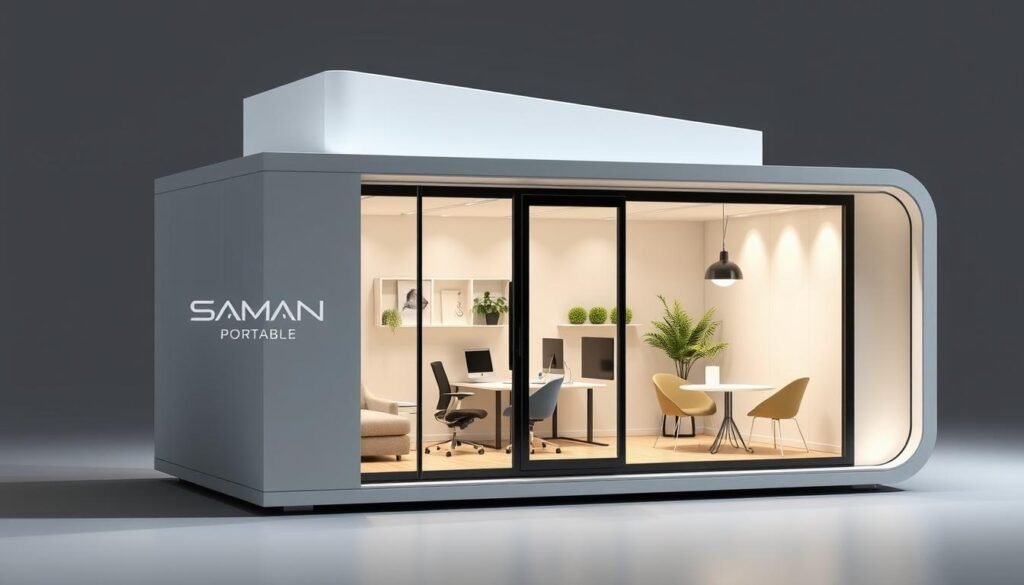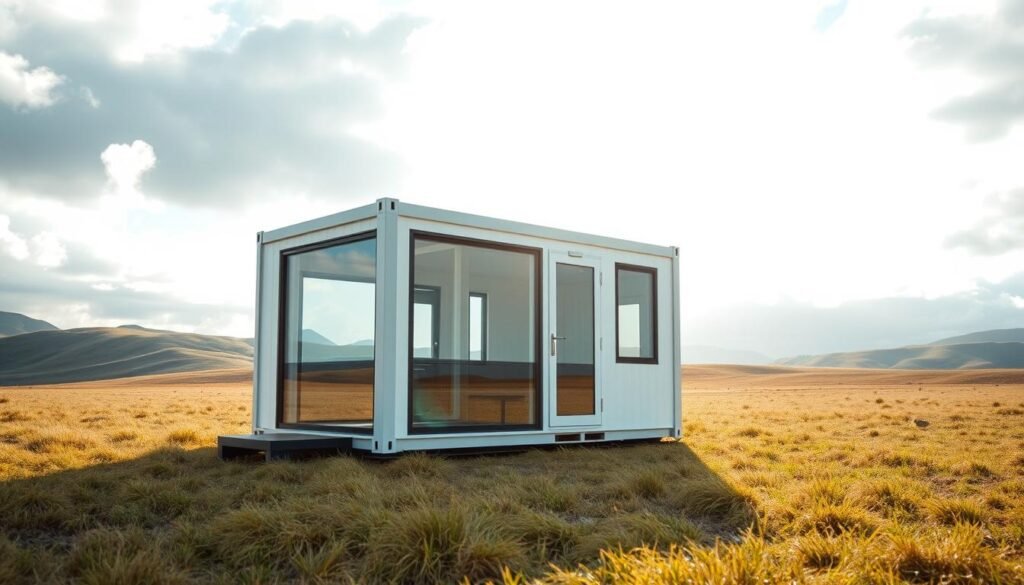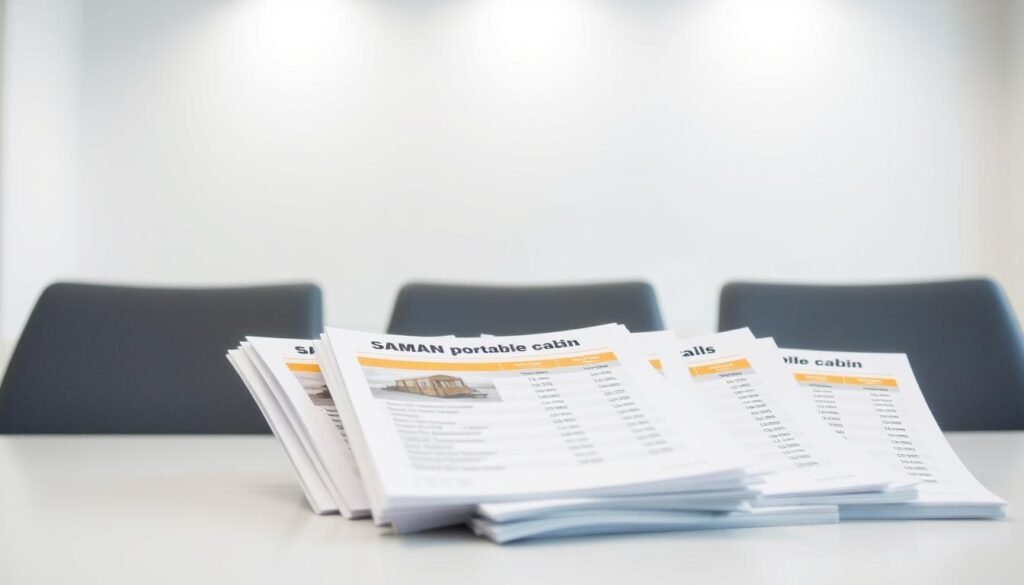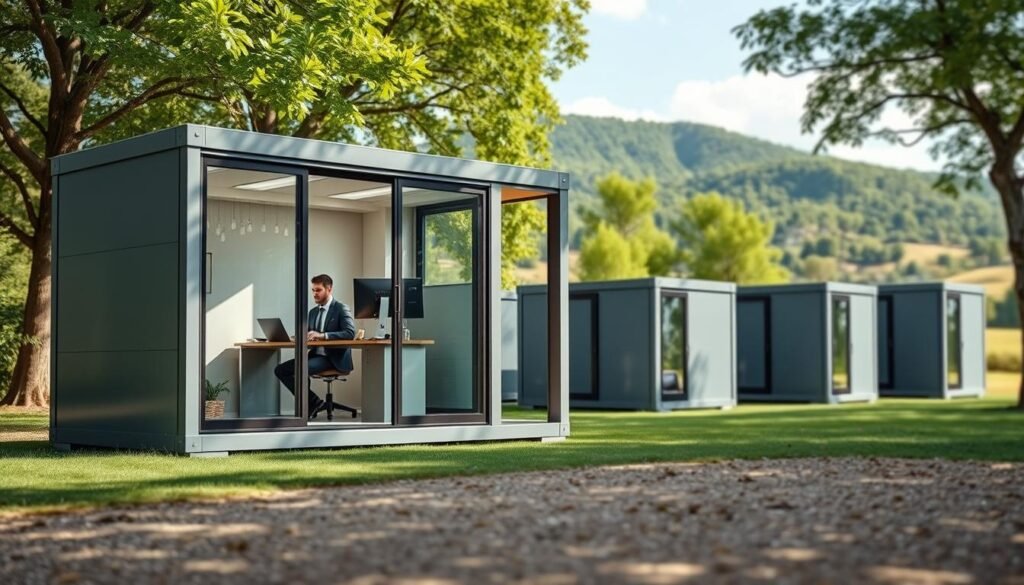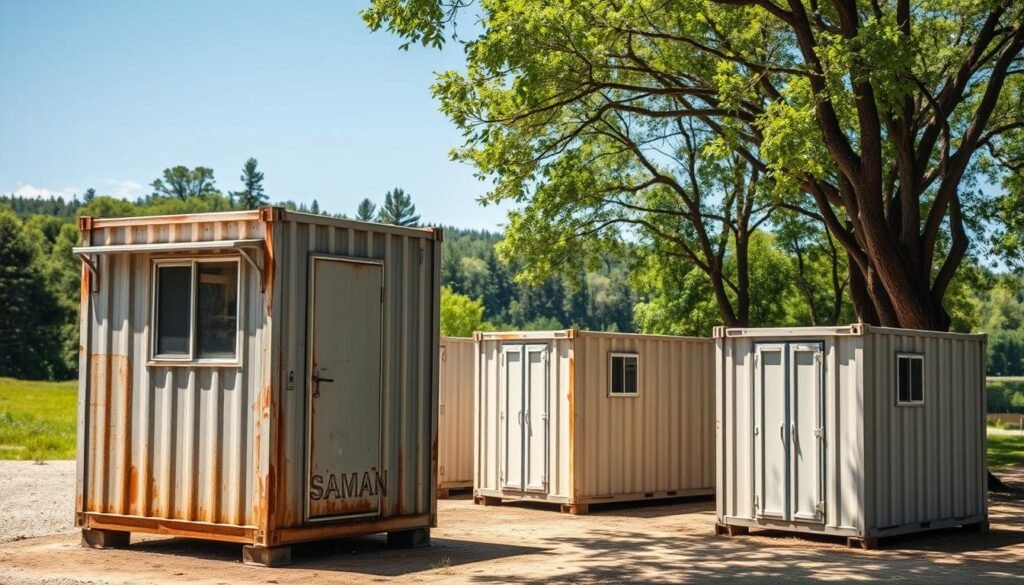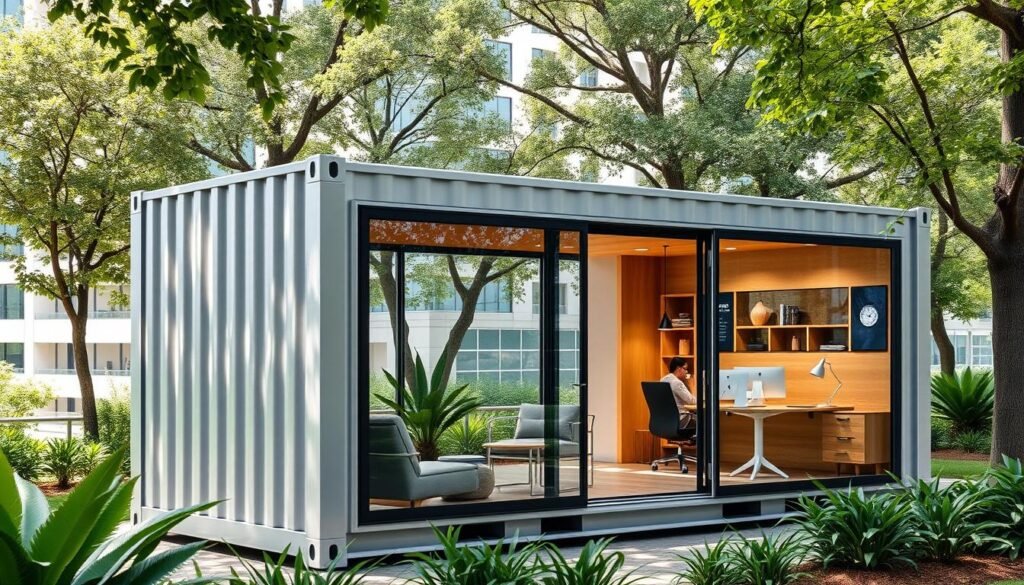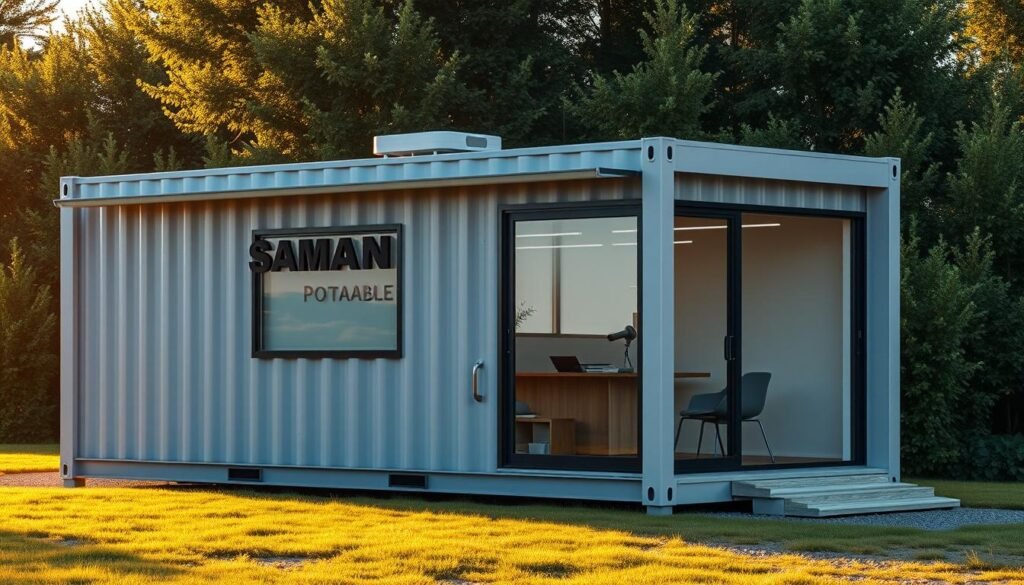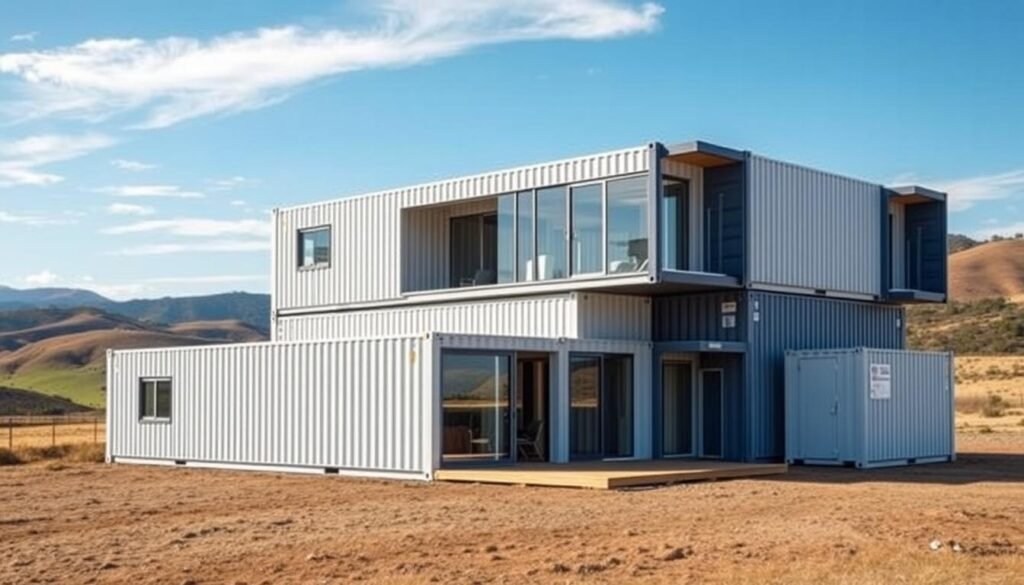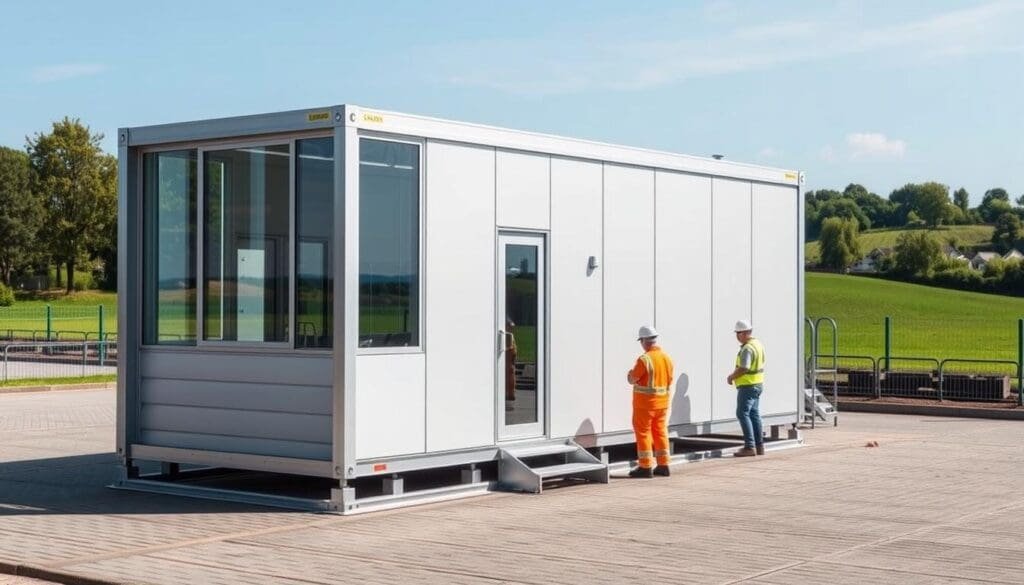Innovative Design Trends 2024 in Site Office Containers for Modern Workspaces
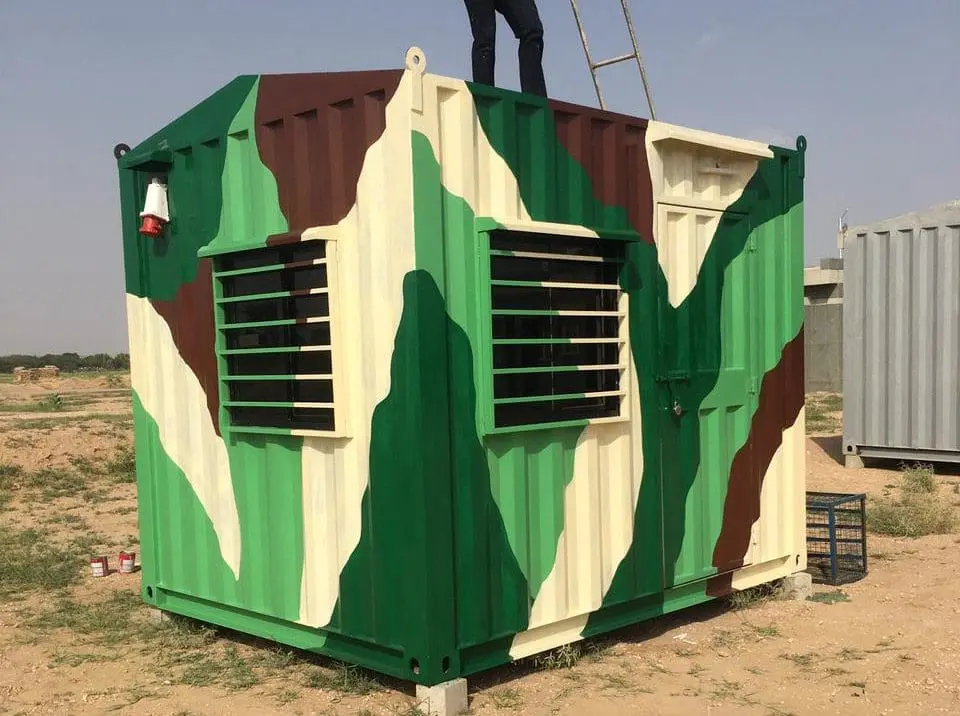
This blog explores the innovative design trends in site office containers, highlighting how these versatile structures have evolved into modern, sustainable workspaces. It covers key topics such as the use of reclaimed materials, green roofs, and energy-efficient design to promote sustainability. The blog also delves into the adaptability of site office containers, emphasizing their mobility, modular growth potential, and the ability to create multi-purpose spaces. Additionally, it discusses the importance of creating a unique aesthetic through industrial minimalism, luxurious finishes, and artistic collaborations. The focus on employee well-being is underscored by the incorporation of biophilic design, ergonomic layouts, wellness spaces, and personalized workstations. Overall, the blog provides a comprehensive overview of how site office containers can be customized to meet the demands of modern businesses while promoting productivity, sustainability, and employee satisfaction.
Introduction: The Rise of Innovative Site Office Containers
Historical Perspective: From Basic Units to Innovative Workspaces
Site office containers have transformed remarkably over the years. Initially, these containers served as simple, functional spaces, primarily used for storage or temporary offices on construction sites. However, as businesses evolved, so did the design of these containers. Today, they are no longer just metal boxes but innovative workspaces tailored to meet modern needs. Their transformation reflects the broader changes in workplace design, where flexibility, sustainability, and efficiency are paramount. The rise of site office containers marks a significant shift in how businesses approach workspace design, offering solutions that are both practical and forward-thinking.
Moreover, site office containers are now seen as a symbol of innovation. Companies across various industries have embraced these structures, recognizing their potential to offer more than just a place to work. They are now designed to be aesthetically pleasing, energy-efficient, and equipped with modern amenities. This shift has been driven by the growing need for adaptable workspaces that can be easily relocated and customized. As a result, site office containers have become a popular choice for businesses looking to stay ahead in a competitive environment, where flexibility and innovation are key.
Furthermore, the journey of site office containers from basic units to innovative workspaces highlights the importance of adaptability. In today’s fast-paced business world, the ability to quickly adjust to changing circumstances is crucial. Site office containers provide this flexibility, allowing companies to create workspaces that can be easily modified or relocated as needed. This adaptability has made them an essential part of the modern workspace landscape, reflecting a trend towards more dynamic and responsive work environments. The rise of these containers underscores the growing demand for innovative solutions in workplace design.
Explore unique industrial designs for your office at Top 10 Container Office Designs.
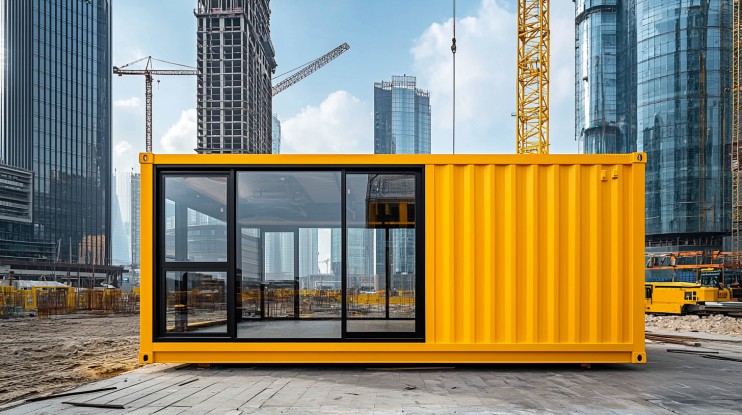
A vibrant yellow 20-foot container office stands out in a busy urban construction site, surrounded by towering cranes and skyscrapers.
Why Innovation Matters in Site Office Containers
Innovation in site office containers is essential for keeping up with the changing needs of businesses. As work environments evolve, so must the spaces where people work. Traditional offices often fail to provide the flexibility that modern businesses require. This is where innovative site office containers come in. They offer customizable solutions that can be tailored to specific business needs, whether that involves creating collaborative spaces or private work areas. By embracing innovation, companies can ensure that their workspaces remain relevant and supportive of their employees’ needs, ultimately leading to increased productivity and satisfaction.
Additionally, the use of innovative site office containers can significantly impact a company’s bottom line. Traditional office spaces are often expensive to build and maintain, requiring significant investment in both time and money. In contrast, site office containers are cost-effective and quick to deploy, making them an attractive option for businesses looking to optimize their resources. Furthermore, these containers are designed with sustainability in mind, incorporating energy-efficient systems and materials that reduce environmental impact. This not only helps companies save on operational costs but also supports their corporate social responsibility goals.
Innovation in site office containers also plays a crucial role in enhancing employee well-being. Modern workers value environments that are comfortable, flexible, and conducive to productivity. Site office containers can be designed to meet these expectations, offering features such as natural lighting, ergonomic furniture, and advanced climate control systems. By providing a workspace that supports employee health and well-being, companies can boost morale and reduce turnover, leading to a more engaged and productive workforce. In today’s competitive business landscape, investing in innovative site office containers is a smart strategy for staying ahead.
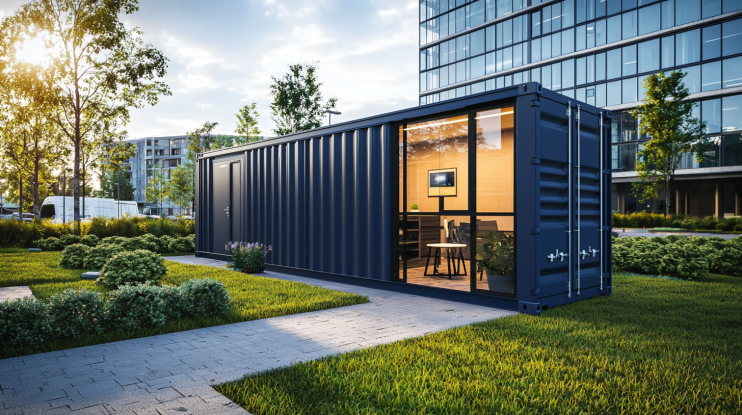
A sleek dark blue container office blends seamlessly into a modern corporate park, offering a professional workspace.
The Influence of Modern Work Culture on Container Design
Modern work culture has a profound impact on the design of site office containers. As businesses shift towards more flexible and dynamic work environments, the need for adaptable office spaces has grown. Site office containers have emerged as a solution to this need, offering customizable spaces that can be easily modified to suit different work styles. Whether it’s an open-plan layout for collaborative teams or private offices for focused work, site office containers can be designed to reflect the diverse needs of today’s workforce. This adaptability makes them an ideal choice for companies looking to create a work environment that fosters productivity and innovation.
Moreover, the emphasis on work-life balance in modern work culture has influenced the way site office containers are designed. Employees today expect more than just a place to work; they want a space that supports their overall well-being. In response, site office containers are being equipped with amenities such as relaxation areas, outdoor spaces, and wellness rooms. These features help create a more holistic work environment, where employees can recharge and stay motivated throughout the day. By incorporating elements that promote well-being, site office containers can help companies attract and retain top talent.
Furthermore, the rise of remote work and hybrid work models has also shaped the design of site office containers. With more employees working from different locations, there is a growing demand for flexible workspaces that can be easily relocated or expanded. Site office containers meet this demand by offering modular designs that can be customized to fit any location. Whether it’s a temporary office on a construction site or a permanent workspace in an urban setting, site office containers provide the flexibility needed to support a modern, mobile workforce. This adaptability is key to meeting the challenges of today’s rapidly changing work environment.
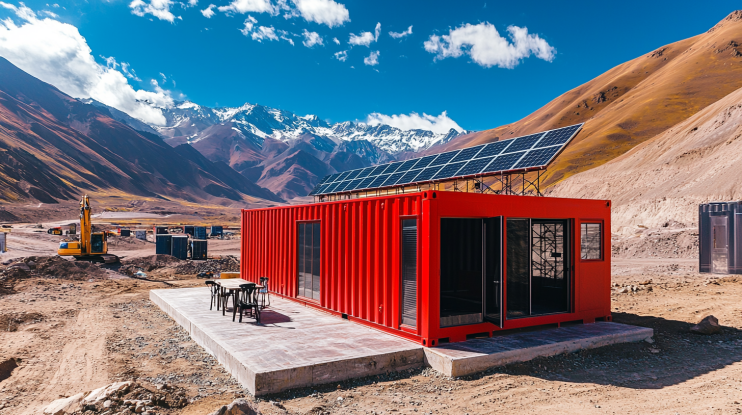
A compact red container office, powered by solar energy, stands resilient in a remote construction site against a mountainous backdrop
Sustainability at the Core of Design
Reclaimed Materials: A New Life for Shipping Containers
Using reclaimed materials in site office containers is not just a trend; it’s a necessity for a sustainable future. Shipping containers, once destined for scrap, are now being repurposed into innovative office spaces. This approach reduces waste and gives these durable structures a second life. By choosing to build with reclaimed containers, companies can significantly reduce their environmental impact. This practice aligns with the growing emphasis on sustainability in the business world, where reducing carbon footprints and promoting eco-friendly practices are becoming top priorities.
Moreover, site office containers made from reclaimed materials offer unique aesthetic appeal. Each container carries its own history, often evident in the wear and tear on its exterior. This adds character and a sense of authenticity to the workspace, something that’s hard to replicate with new materials. The industrial look of these containers can be enhanced with modern finishes and fittings, creating a workspace that’s both stylish and sustainable. The use of reclaimed materials also resonates with clients and employees who value environmental responsibility, making it a smart choice for businesses aiming to enhance their brand image.
Additionally, using reclaimed materials in site office containers is cost-effective. The initial cost of acquiring a used shipping container is generally lower than that of new building materials. This makes site office containers an affordable solution for businesses looking to expand or set up new offices without breaking the bank. Furthermore, the modular nature of these containers means they can be easily expanded or reconfigured as business needs change, providing long-term value. In an era where sustainability and cost-efficiency are crucial, reclaimed shipping containers offer a practical and impactful solution.
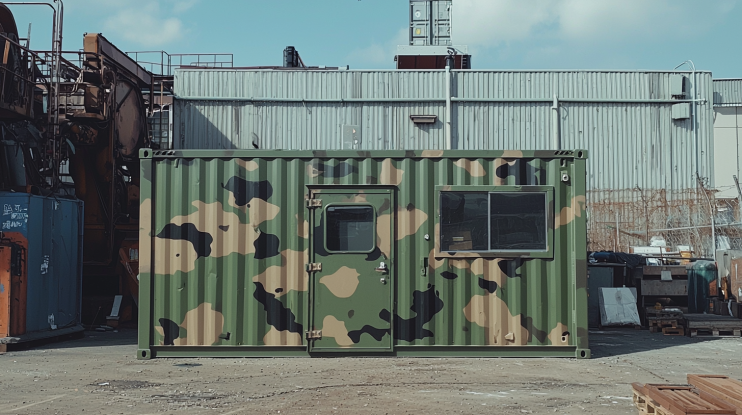
A camouflaged green container office blends into the industrial surroundings, offering a discreet workspace.
Green Roofs and Living Walls: Bringing Nature into the Office
Incorporating green roofs and living walls into site office containers is a powerful way to connect employees with nature. These features not only enhance the aesthetic appeal of the workspace but also contribute to a healthier environment. Green roofs, covered with vegetation, provide natural insulation, reducing the need for heating and cooling systems. This leads to lower energy consumption and a smaller carbon footprint. Similarly, living walls, which are vertical gardens installed on interior or exterior walls, improve air quality by filtering pollutants and releasing oxygen.
Moreover, green roofs and living walls create a more pleasant and productive work environment. Studies have shown that exposure to nature can reduce stress, improve mood, and boost creativity. By integrating these features into site office containers, companies can create a workspace that promotes employee well-being and satisfaction. The presence of greenery also adds a calming effect, making the office feel more inviting and less industrial. This is particularly important in urban settings, where access to nature is limited. Green roofs and living walls bring the outdoors in, making the workspace more enjoyable and conducive to productivity.
Furthermore, green roofs and living walls are a visible commitment to sustainability, enhancing a company’s reputation as an environmentally responsible business. Clients, partners, and employees are increasingly drawn to companies that prioritize eco-friendly practices. By incorporating these features into site office containers, businesses can showcase their commitment to environmental stewardship. This not only helps attract and retain top talent but also strengthens the company’s brand image. In a world where sustainability is increasingly valued, green roofs and living walls are a forward-thinking addition to site office containers.
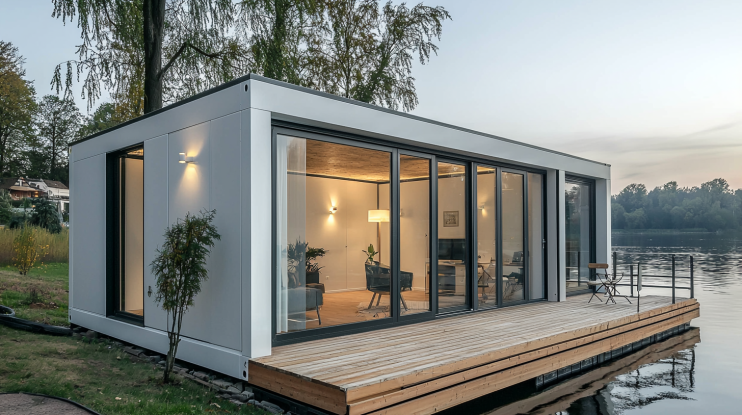
A serene white container office with a small deck offers peaceful lakeside views, creating a tranquil workspace.
Water Conservation: Innovative Systems in Site Office Containers
Water conservation is a critical aspect of sustainable design in site office containers. Innovative systems such as rainwater harvesting and greywater recycling are becoming standard features in these workspaces. Rainwater harvesting systems collect and store rainwater for non-potable uses, such as irrigation or flushing toilets. This reduces the demand on municipal water supplies and lowers water bills. Greywater recycling, on the other hand, involves treating wastewater from sinks, showers, and washing machines for reuse in irrigation or flushing. These systems are particularly beneficial in areas prone to water scarcity, where conservation is essential.
Moreover, integrating water conservation systems into site office containers is a practical way to reduce operational costs. By reusing water, companies can significantly cut down on their utility expenses. This is especially important for businesses that operate in regions with high water costs or strict water usage regulations. The savings generated from these systems can be reinvested into other areas of the business, such as employee benefits or sustainability initiatives. Additionally, water conservation systems are low-maintenance, requiring minimal upkeep once installed, making them a cost-effective solution in the long run.
Furthermore, adopting water conservation systems in site office containers demonstrates a commitment to environmental responsibility. In a time when natural resources are under increasing pressure, businesses that take proactive steps to conserve water set themselves apart as leaders in sustainability. This commitment can enhance a company’s reputation and build trust with clients, employees, and stakeholders. By investing in water-saving technologies, site office containers not only support a greener planet but also contribute to a positive brand image. In the competitive business landscape, such initiatives can be a key differentiator.
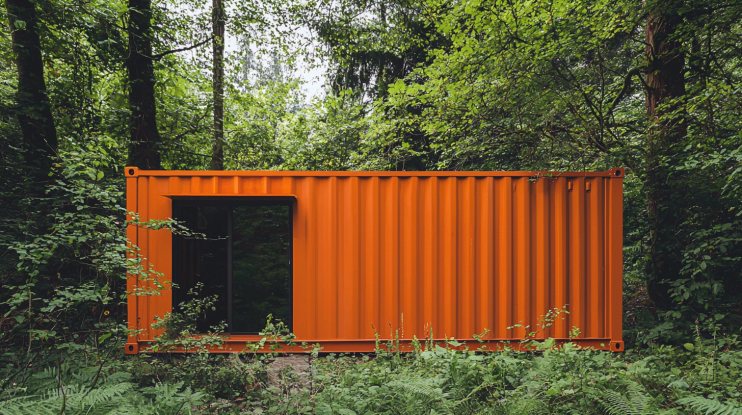
A highly visible orange container office stands at the edge of a dense forest, offering a unique and accessible workspace.
Energy Efficiency: Passive Design Strategies in Container Offices
Energy efficiency is a cornerstone of sustainable design in site office containers. Passive design strategies, which focus on maximizing natural light and ventilation, play a crucial role in reducing energy consumption. These strategies include orienting the container to take advantage of sunlight, using high-performance windows, and incorporating shading devices to minimize heat gain. By harnessing natural energy sources, site office containers can maintain comfortable indoor temperatures without relying heavily on artificial heating or cooling systems. This not only lowers energy bills but also reduces the environmental impact of the workspace.
Moreover, passive design strategies contribute to a more comfortable and healthy work environment. Natural light, for instance, has been shown to improve mood, boost productivity, and reduce eye strain. By designing site office containers to maximize natural light, companies can create a brighter and more pleasant workspace for their employees. Similarly, natural ventilation helps improve indoor air quality by reducing the concentration of pollutants and providing a steady supply of fresh air. This can lead to fewer sick days and higher overall employee satisfaction, making the workspace more conducive to productivity and well-being.
Furthermore, the adoption of passive design strategies in site office containers is a smart investment for businesses looking to future-proof their operations. As energy costs continue to rise and regulations around energy efficiency become more stringent, businesses that prioritize energy-efficient design will be better positioned to adapt. Site office containers that incorporate passive design strategies not only meet current sustainability standards but also anticipate future requirements. This proactive approach can save businesses money, reduce their carbon footprint, and enhance their reputation as leaders in sustainable workplace design.
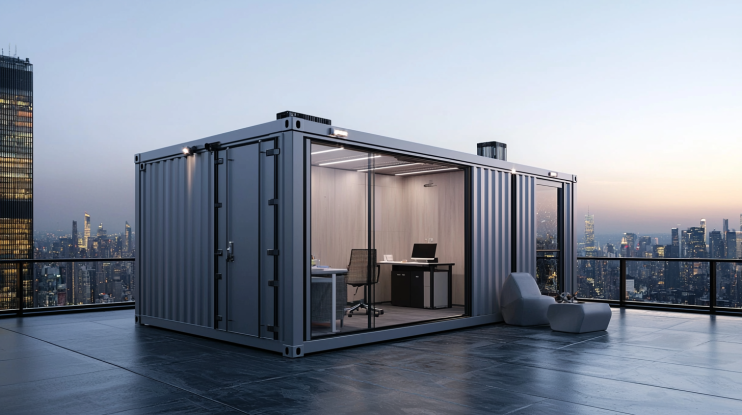
A modern light gray container office offers a stylish workspace with panoramic city skyline views from an urban rooftop.
Design for Mobility and Flexibility
Adaptive Interiors: Multi-Purpose Spaces in Site Office Containers
One of the most significant advantages of site office containers is their adaptability. These containers can be transformed into multi-purpose spaces that meet various business needs. For instance, a single container can serve as an office during the day and a meeting room in the afternoon. By using modular furniture and movable walls, businesses can reconfigure the space as needed. This flexibility is especially valuable for companies that need to maximize limited space. It also allows businesses to adapt quickly to changing needs without the need for extensive renovations or additional construction.
Moreover, adaptive interiors in site office containers promote a more efficient use of space. Instead of dedicating separate rooms for different functions, companies can design their containers to accommodate multiple activities. For example, a workspace can easily be converted into a break room by folding away desks and bringing out lounge chairs. This kind of versatility is not only practical but also cost-effective, as it reduces the need for additional square footage. By making the most of every inch of space, businesses can create a dynamic and efficient work environment that supports productivity and collaboration.
Furthermore, adaptive interiors in site office containers contribute to a more inclusive work environment. Different employees have different needs, and a flexible space can accommodate these differences. For instance, some employees may prefer quiet spaces for focused work, while others thrive in open, collaborative settings. By incorporating movable walls and modular furniture, businesses can create spaces that can be easily reconfigured to suit the preferences of their employees. This adaptability not only improves employee satisfaction but also enhances overall productivity, making site office containers an ideal solution for modern workplaces.
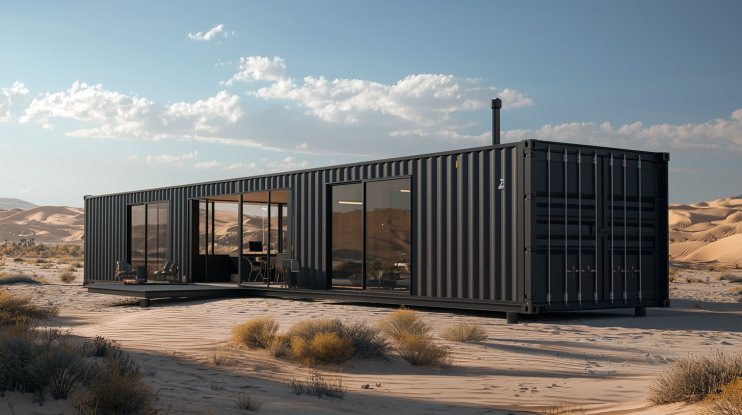
A rugged black container office stands resilient in a harsh desert environment, blending into the stark landscape.
Mobile Workspaces: Containers on the Move
Site office containers are not just stationary workspaces; they can also be mobile, providing flexibility for businesses that need to move frequently. These mobile workspaces can be easily transported to different locations, making them ideal for construction sites, events, and remote projects. The ability to move a fully functional office from one place to another offers unparalleled convenience. Businesses can set up their operations quickly, without the need for permanent infrastructure. This mobility is particularly beneficial for industries that require on-site management or temporary offices.
Additionally, mobile site office containers are designed to be self-sufficient, equipped with everything needed to operate in remote locations. They often include built-in power sources, water tanks, and waste management systems, allowing them to function independently of local utilities. This makes them perfect for use in areas where access to such services is limited or unavailable. The mobility of these containers also means they can be repositioned to take advantage of changing site conditions, such as moving closer to the action on a construction site or being relocated for better access to resources.
Furthermore, the use of mobile site office containers can significantly reduce operational costs. Instead of building new offices at each location, businesses can simply transport their existing containers to the new site. This not only saves time and money but also reduces waste and the environmental impact associated with constructing new buildings. By investing in mobile workspaces, companies can maintain a consistent and efficient work environment, regardless of where their projects take them. This flexibility is a game-changer for businesses that operate in multiple locations or require frequent relocations.
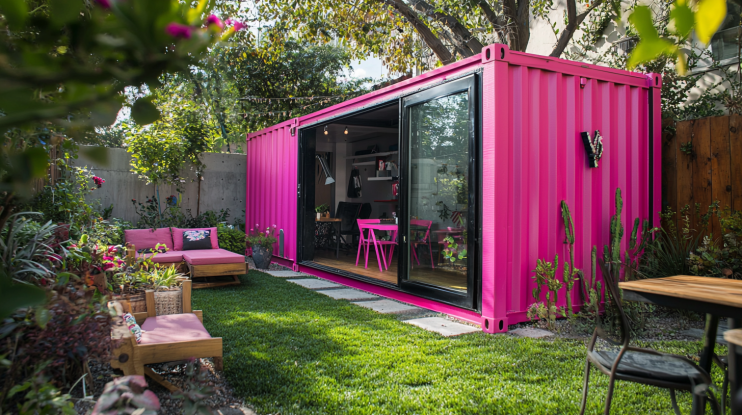
A playful pink container office adds a vibrant touch to a residential backyard, offering a compact and creative workspace.
Flexible Expansion: Modular Growth in Site Office Containers
Flexible expansion is one of the key benefits of using site office containers. These containers are modular by design, meaning they can be easily expanded or reduced in size to meet the changing needs of a business. If a company needs to grow its workforce, additional containers can be added to the existing structure, creating more office space without the need for major construction. This modular approach allows businesses to scale their operations quickly and efficiently, responding to changes in demand without the constraints of traditional office buildings.
Moreover, the process of expanding site office containers is straightforward and cost-effective. Unlike traditional buildings, which require extensive planning and construction work, adding new containers to an existing setup is relatively simple. Containers can be stacked or connected side by side, creating multi-level offices or expanding the footprint of the workspace. This flexibility is particularly beneficial for businesses in fast-growing industries, where the ability to scale quickly is crucial. By using site office containers, companies can avoid the delays and costs associated with traditional construction, allowing them to focus on their core operations.
Furthermore, the modular nature of site office containers also makes them ideal for temporary or seasonal expansions. Businesses that experience fluctuations in demand can easily add or remove containers as needed, without committing to long-term leases or construction projects. This flexibility helps companies manage their resources more effectively, ensuring they have the right amount of space at the right time. Whether expanding for a temporary project or scaling up for long-term growth, site office containers offer a practical and efficient solution for businesses looking to stay agile in a dynamic market.
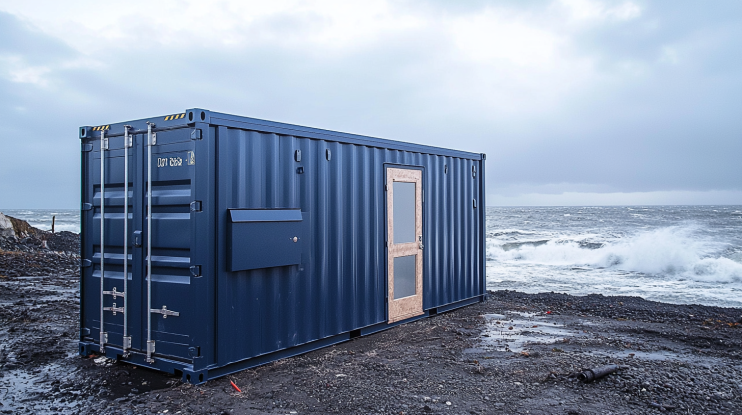
A sturdy navy blue container office stands strong at a remote coastal site, offering a secure workspace by the sea.
Temporary Installations: Pop-Up Offices with Style
Site office containers are perfect for creating temporary installations, such as pop-up offices, that are both functional and stylish. These pop-up offices can be set up quickly and dismantled just as easily, making them ideal for short-term projects, events, or seasonal businesses. Despite their temporary nature, pop-up offices made from site office containers do not compromise on style or comfort. They can be customized with modern finishes, stylish furniture, and the latest technology, creating a workspace that is both practical and visually appealing.
Moreover, pop-up offices using site office containers offer businesses a unique way to make a statement. These offices can be branded with company logos and colors, creating a strong visual identity that attracts attention. Whether used for a temporary headquarters at an event or a seasonal retail space, pop-up offices can help businesses stand out and make a lasting impression on clients and customers. The flexibility of site office containers means that these pop-up offices can be tailored to fit any brand or purpose, making them a versatile option for businesses looking to create a memorable presence.
Furthermore, pop-up offices provide a cost-effective solution for businesses that need temporary space. Traditional office rentals can be expensive and often require long-term commitments. In contrast, site office containers can be rented or purchased for short-term use, offering a more affordable and flexible alternative. Once the project or event is over, the containers can be easily moved to a new location or stored for future use. This flexibility, combined with the ability to create stylish and functional workspaces, makes site office containers an ideal choice for temporary installations.
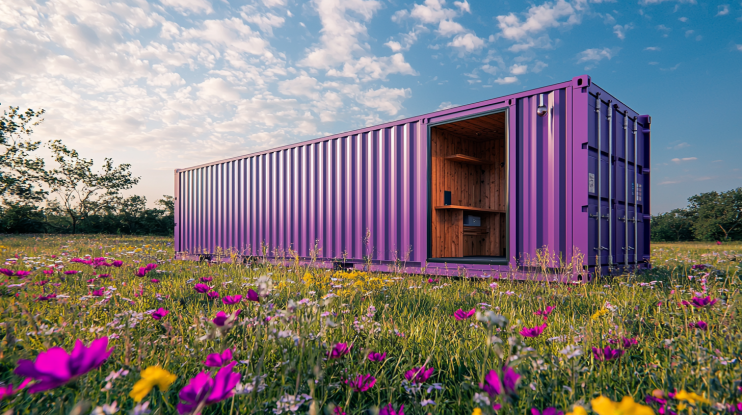
A rustic purple container office with wooden accents offers a creative workspace amidst a field of wildflowers.
Creating a Unique Aesthetic
Industrial Minimalism: Embracing the Raw Container Look
Industrial minimalism is a popular design trend in site office containers, where the raw, unfinished look of the container is embraced as a key aesthetic element. This design approach highlights the container’s industrial origins, with exposed metal surfaces, visible welds, and a minimalist color palette. The result is a workspace that feels modern, edgy, and sophisticated. By keeping the design simple and focusing on the container’s natural characteristics, businesses can create an office that stands out for its unique style and functionality.
Moreover, industrial minimalism in site office containers is not just about aesthetics; it’s also practical. The minimalist approach means fewer materials are needed for interior finishes, reducing both costs and environmental impact. The focus on functionality and simplicity ensures that the workspace is efficient and easy to maintain. Additionally, the use of industrial materials like steel and concrete contributes to the durability and longevity of the office, making it a long-term investment. This combination of style and practicality makes industrial minimalism a popular choice for businesses looking to create a distinctive and functional workspace.
Furthermore, the industrial minimalist design in site office containers can be easily customized to reflect a company’s brand and values. While the raw look of the container is the focal point, businesses can add their own touches through furniture, lighting, and accessories. For instance, sleek, modern furniture can complement the industrial look, while strategically placed lighting can enhance the overall ambiance. This flexibility allows businesses to create a workspace that is both stylish and representative of their brand identity. Industrial minimalism offers a unique blend of form and function, making it an ideal design choice for site office containers.
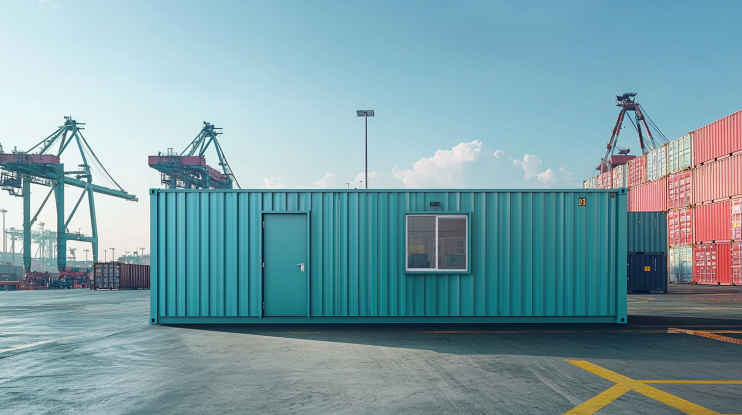
A practical teal container office is strategically positioned at a bustling port, offering a functional workspace in an industrial setting.
10 Innovative Designs for Container Offices
1. Modular Multi-Story Offices
These designs stack multiple containers to create multi-level office spaces. Ideal for businesses needing to maximize limited space, each level can serve different purposes, from workspaces to meeting rooms. Modular multi-story offices offer scalability, allowing companies to easily add or remove levels as needed.
2. Portable Pop-Up Offices
Portable pop-up offices are designed for temporary use at events, construction sites, or remote locations. These offices are easy to transport and set up, providing fully functional workspaces wherever needed. They are compact, quick to deploy, and perfect for businesses on the move.
3. Green Roof Offices
These container offices feature green roofs covered with vegetation, enhancing sustainability and insulation. Green roof offices reduce energy costs, improve air quality, and provide a natural aesthetic. They’re ideal for businesses focused on eco-friendly practices and employee well-being.
4. Hybrid Office and Storage Containers
This design combines office space with secure storage within the same container. Perfect for businesses needing both workspace and storage on-site, hybrid containers optimize space while providing secure, lockable storage areas for equipment or documents.
5. Solar-Powered Offices
Equipped with solar panels, these container offices operate independently of the grid, making them ideal for remote locations. Solar-powered offices promote eco-friendly practices, reduce operational costs, and ensure energy self-sufficiency for businesses.
6. Expandable Container Offices
Expandable container offices feature sides that can slide out to increase interior space. This design allows for flexible use of space, enabling businesses to create larger work areas or meeting rooms as needed, while still being easily transportable.
7. Luxury Office Suites
Luxury container offices transform standard containers into high-end workspaces with premium finishes, smart technology, and sleek designs. These suites provide a sophisticated and comfortable environment, perfect for impressing clients and boosting employee morale.
8. Open-Plan Workspaces
Open-plan container offices encourage collaboration and communication by creating spacious, flexible work areas. These designs are ideal for creative teams or start-ups that value teamwork, with large windows and movable furniture to enhance the workspace.
9. Offices with Meeting Pods
This design integrates private meeting pods within the container, offering quiet spaces for focused work or small meetings. Offices with meeting pods are perfect for businesses that require multiple private zones within a compact office environment.
10. Offices with Outdoor Decks
Container offices with outdoor decks provide employees with a place to relax and enjoy fresh air. These designs combine indoor and outdoor spaces, promoting a balanced work environment that supports well-being and productivity.
For more details, visit Top 10 Container Office Designs.
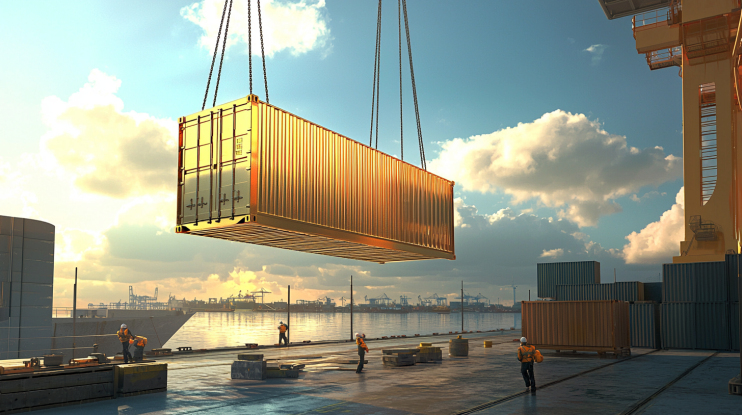
A metallic gold container office hovers above a busy dockside, ready to embark on its next journey.
Luxurious Touches: High-End Finishes for Premium Container Offices
Adding luxurious touches to site office containers can transform these functional spaces into high-end, premium offices. While the exterior of the container may retain its industrial look, the interior can be outfitted with high-end finishes such as hardwood floors, custom cabinetry, and designer lighting. These elements create a workspace that feels more like a boutique office than a converted shipping container. The use of premium materials and finishes elevates the overall aesthetic, making the office a comfortable and inviting place to work.
Moreover, luxurious touches in site office containers go beyond just aesthetics; they also enhance the functionality of the space. High-end finishes often include advanced technology and modern amenities that improve the work environment. For example, integrated smart systems can control lighting, temperature, and security, providing convenience and efficiency. Custom furniture designed specifically for the container’s dimensions can maximize space while maintaining a sleek and modern look. By combining luxury with functionality, businesses can create a workspace that meets the highest standards of comfort and productivity.
Furthermore, investing in luxurious finishes for site office containers can have a positive impact on employee satisfaction and client impressions. A well-designed, premium office space can boost employee morale, making the workplace more enjoyable and motivating. It also creates a professional image that can impress clients and visitors, reflecting positively on the company’s brand. Whether used as a permanent office or a temporary space, site office containers with luxurious touches offer a unique and sophisticated work environment that sets businesses apart.
For luxurious office design ideas, check out Shipping Container Office Solutions.
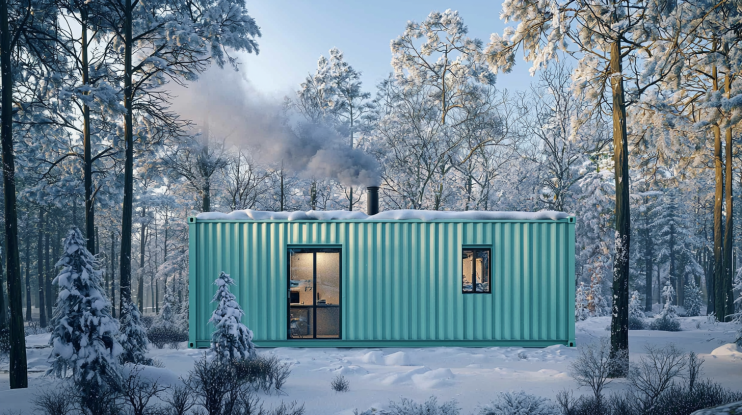
A cozy mint green container office provides a warm refuge in the midst of a snow-covered forest.
Artistic Collaborations: Custom Art and Design in Container Offices
Artistic collaborations can bring a creative and personalized touch to site office containers. By partnering with local artists or designers, businesses can transform their container offices into works of art that reflect their brand and values. Custom murals, sculptures, or installations can be integrated into the design, making the office space truly unique. These artistic elements not only enhance the visual appeal of the office but also create an inspiring environment that fosters creativity and innovation among employees.
Moreover, artistic collaborations in site office containers can help businesses connect with the local community. By showcasing the work of local artists, companies can support the arts and create a sense of place within their office. This connection to the community can enhance the company’s brand image, making it more relatable and authentic. Additionally, the use of art in the office can create a more engaging and dynamic workspace, where employees feel inspired and motivated to do their best work. Artistic collaborations offer a way to personalize site office containers while supporting local talent and fostering a positive work environment.
Furthermore, custom art and design in site office containers can be a powerful tool for branding and marketing. A visually striking office space can attract attention and generate buzz, both online and offline. Businesses can use their unique office design as a marketing tool, showcasing it on social media or in promotional materials. This not only helps build brand awareness but also sets the company apart from competitors. By investing in artistic collaborations, businesses can create a site office container that is not only functional but also a statement piece that reflects their brand’s identity and values.
Discover how custom art can enhance your workspace by visiting Container Offices for Sale.
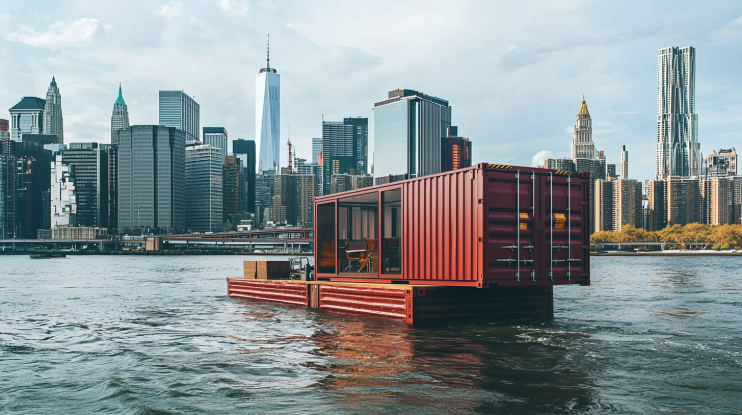
A deep maroon container office turns a barge into a mobile workspace on a bustling river, with city skyscrapers towering in the background.
Color Psychology: Using Color Schemes to Influence Productivity
Color psychology plays a significant role in the design of site office containers, as the colors used in the workspace can influence mood, productivity, and overall well-being. Different colors evoke different emotional responses, and choosing the right color scheme can create an environment that supports the specific needs of a business. For example, blue is often associated with calmness and focus, making it an ideal choice for spaces where concentration is important. On the other hand, yellow is known for its energizing and creative properties, making it suitable for areas where brainstorming and collaboration take place.
Moreover, color psychology in site office containers can be used to create distinct zones within the workspace. By using different colors for different areas, businesses can visually separate spaces designed for different activities. For instance, a calming color like green can be used in break areas to create a relaxing atmosphere, while a bold color like red can be used in meeting rooms to stimulate energy and discussion. This strategic use of color helps create a more organized and functional workspace, where each area is tailored to its intended use. The thoughtful application of color psychology can enhance both the aesthetic and functionality of site office containers.
Furthermore, incorporating color psychology into the design of site office containers can improve employee satisfaction and productivity. A well-chosen color scheme can make the workspace more pleasant and inviting, reducing stress and boosting morale. Employees who feel comfortable and happy in their work environment are more likely to be productive and engaged. Additionally, the use of color can reflect a company’s brand identity, creating a cohesive and professional look throughout the office. By considering color psychology in the design process, businesses can create a site office container that not only looks great but also supports a positive and productive work environment.
Learn how to apply color psychology in your office design at Shipping Container Office Solutions.
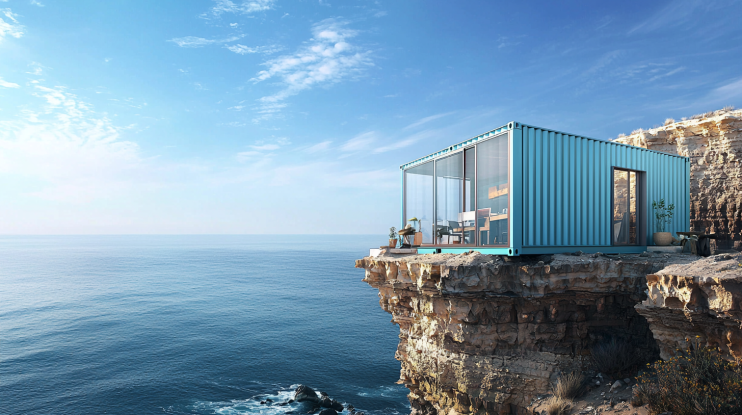
A sky blue container office offers breathtaking panoramic views from its cliffside perch above the ocean.
Enhancing Employee Experience through Design
Biophilic Design: Incorporating Natural Elements for Well-being
Biophilic design is all about bringing nature into the workplace, and it’s a concept that works beautifully in site office containers. By incorporating natural elements such as plants, water features, and natural light, businesses can create a calming and invigorating workspace. Biophilic design has been shown to reduce stress, improve mood, and increase productivity. In a site office container, this might mean installing large windows to let in natural light, adding indoor plants, or even incorporating a small indoor garden. These natural elements help create a connection to the outdoors, which is essential for employee well-being.
Moreover, biophilic design in site office containers can lead to a healthier work environment. Plants, for example, are not just decorative; they also help purify the air by removing toxins and releasing oxygen. This improves indoor air quality, which can reduce the risk of respiratory issues and improve overall health. Natural light, another key component of biophilic design, helps regulate circadian rhythms, leading to better sleep and increased energy levels. By prioritizing biophilic design in site office containers, businesses can create a workspace that promotes both physical and mental well-being.
Furthermore, incorporating biophilic design into site office containers can enhance employee satisfaction and retention. A workspace that feels connected to nature can make employees feel more relaxed and content, leading to higher job satisfaction. This, in turn, can reduce turnover and attract top talent. Additionally, a biophilic workspace can reflect positively on a company’s brand, demonstrating a commitment to employee well-being and environmental sustainability. In a competitive job market, offering a workspace that prioritizes the health and happiness of employees can be a significant advantage.
Explore how to integrate biophilic design into your workspace at Top 10 Container Office Designs.
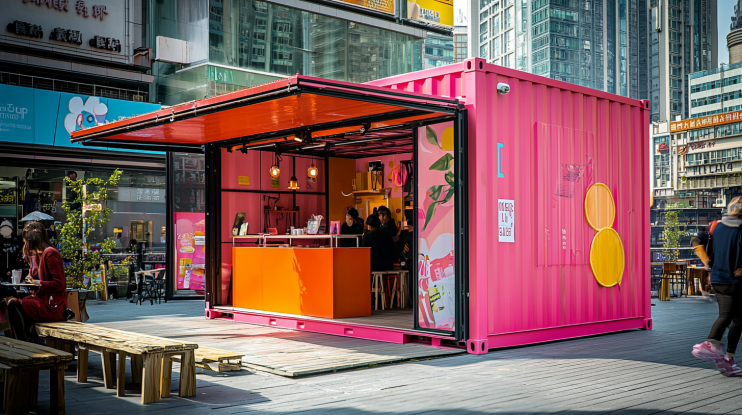
A vibrant crimson red container office transforms into a bustling pop-up shop in the heart of downtown.
Ergonomic Layouts: Designing for Comfort and Health
Creating an ergonomic layout in site office containers is crucial for promoting comfort and health among employees. Ergonomics focuses on designing workspaces that fit the needs of the user, reducing the risk of injury and improving overall well-being. In a site office container, this means carefully planning the placement of furniture, equipment, and workstations to ensure they are accessible and comfortable. For instance, desks and chairs should be adjustable to accommodate different body types, and computer screens should be positioned at eye level to reduce strain on the neck and eyes.
Moreover, an ergonomic layout in site office containers can improve productivity and reduce absenteeism. When employees work in a space that is comfortable and supports their physical needs, they are less likely to experience discomfort or injury. This leads to fewer sick days and higher levels of productivity. Additionally, ergonomic workspaces can reduce the risk of repetitive strain injuries, which are common in office environments. By investing in ergonomic design, businesses can create a healthier and more efficient workspace that benefits both employees and the company as a whole.
Furthermore, ergonomic layouts in site office containers can contribute to a positive work culture. When employees feel that their comfort and well-being are prioritized, they are more likely to be satisfied with their job and loyal to their employer. This can lead to higher levels of employee engagement and a stronger sense of community within the workplace. An ergonomic workspace also reflects a company’s commitment to health and safety, which can enhance its reputation and attract top talent. In today’s competitive job market, offering an ergonomic work environment is an important factor in retaining and attracting employees.
Learn more about creating ergonomic workspaces at Container Offices for Sale.
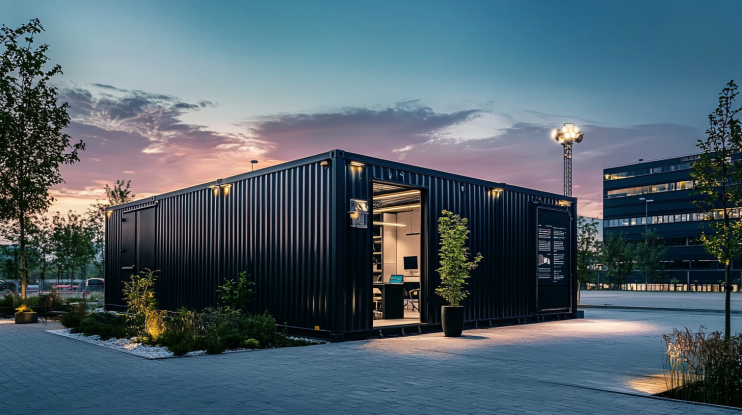
A sleek jet black container office is the centerpiece of a futuristic tech campus, featuring cutting-edge technology and robotic assistants.
Wellness Spaces: Integrating Relaxation Zones in Site Office Containers
Integrating wellness spaces into site office containers is an excellent way to promote employee well-being. These spaces provide a designated area for employees to relax, recharge, and take a break from their work. Wellness spaces can include features such as comfortable seating, soft lighting, and calming decor, creating a tranquil environment that encourages relaxation. By providing a space where employees can unwind, businesses can help reduce stress and prevent burnout, leading to a healthier and more productive workforce.
Moreover, wellness spaces in site office containers can be tailored to meet the specific needs of the employees. For example, some businesses might choose to include a meditation room, while others might opt for a small gym or yoga space. The key is to create a space that supports the well-being of the employees and encourages them to take regular breaks. These breaks are essential for maintaining focus and productivity, as they allow employees to return to their work refreshed and re-energized. By investing in wellness spaces, businesses can create a more balanced and supportive work environment.
Furthermore, wellness spaces in site office containers can enhance employee satisfaction and retention. A workplace that prioritizes wellness is more likely to attract and retain top talent, as employees increasingly seek out employers who care about their well-being. Wellness spaces can also help build a positive work culture, where employees feel valued and supported. This can lead to higher levels of engagement and a stronger sense of community within the workplace. By integrating wellness spaces into site office containers, businesses can create a workspace that promotes both physical and mental well-being.
Discover how to create wellness spaces in your office at Portable Container Offices.
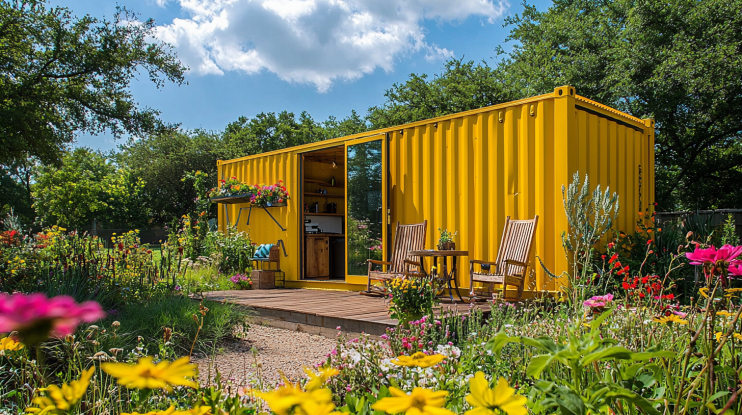
A bright lemon yellow container office nestled in a blooming countryside garden, offering a warm and welcoming workspace.
Personalized Workspaces: Customization for Employee Satisfaction
Personalized workspaces in site office containers can greatly enhance employee satisfaction and productivity. Allowing employees to customize their workspaces gives them a sense of ownership and control over their environment. This can include choosing their desk setup, adding personal decor, or selecting ergonomic furniture that suits their needs. Personalized workspaces help employees feel more comfortable and connected to their work, leading to higher levels of job satisfaction. In a site office container, this might mean providing flexible furniture options or creating spaces that can be easily reconfigured to suit individual preferences.
Moreover, personalized workspaces in site office containers can foster creativity and innovation. When employees have the freedom to design their own workspace, they are more likely to feel inspired and motivated. This can lead to new ideas and approaches that benefit the company as a whole. Personalized workspaces also encourage employees to take ownership of their work, leading to increased engagement and productivity. By supporting customization, businesses can create a dynamic and flexible work environment that adapts to the needs of their employees.
Furthermore, offering personalized workspaces can be a key factor in employee retention and attraction. In today’s competitive job market, employees are looking for workplaces that offer flexibility and personalization. By allowing employees to create a workspace that suits their needs, businesses can demonstrate their commitment to employee satisfaction and well-being. This can help attract top talent and reduce turnover, as employees are more likely to stay with a company that values their individuality. Personalized workspaces in site office containers offer a unique and effective way to enhance employee satisfaction and support a positive work environment.
For ideas on personalized workspace designs, visit Shipping Container Office Solutions.
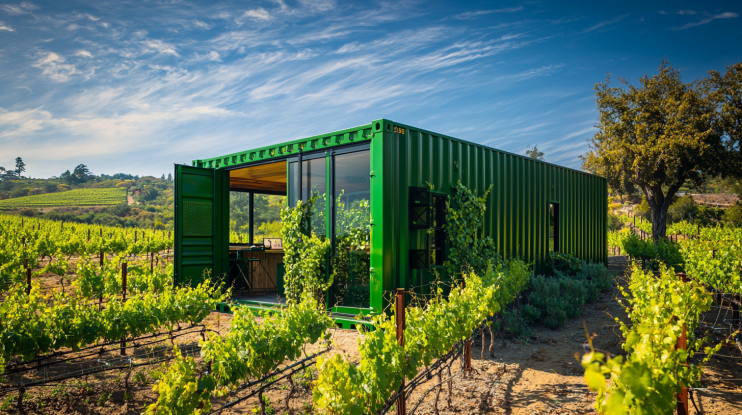
An emerald green container office blends seamlessly into the vineyard, providing a functional workspace among the grapevines.
Conclusion
Site office containers are rapidly becoming a cornerstone of modern workspaces, offering flexibility, sustainability, and a unique aesthetic that traditional offices often lack. From the use of reclaimed materials and energy-efficient designs to the ability to easily expand and adapt, these containers meet the evolving needs of today’s businesses. By integrating thoughtful design elements like biophilic features, ergonomic layouts, and customizable spaces, companies can create work environments that boost productivity and support employee well-being.
Moreover, the versatility of site office containers allows businesses to respond quickly to changing demands, whether it’s through mobile workspaces, temporary pop-up offices, or permanent installations. This adaptability makes them an ideal solution for businesses of all sizes, providing both functional and inspiring workspaces that align with modern values of sustainability and efficiency.
As you consider the potential of site office containers for your business, exploring these innovative design trends can help you create a workspace that not only meets your operational needs but also enhances your company’s brand and culture. For more insights and options, Explore Container Office Solutions or Contact Us to discuss how we can help you transform your work environment.
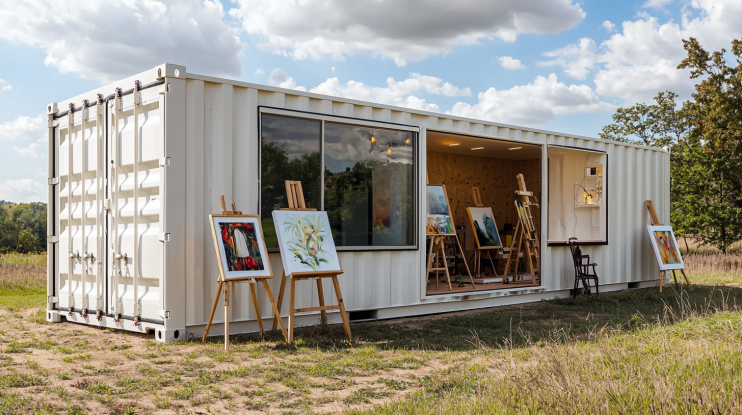
An ivory white container office transforms into an inspiring art studio in an open field, bathed in natural light.
FAQs About Site Office Containers
What are the standard sizes of site office containers?
Site office containers typically come in standard sizes of 20 feet and 40 feet in length. The standard height is 8 feet 6 inches, and the width is 8 feet. Smaller sizes, such as 10 feet or larger options like 24 feet, are also available depending on your specific needs.
How long do site office containers last?
With proper care and maintenance, site office containers can last over 25 years. Factors like environmental conditions, frequency of use, and regular upkeep significantly impact their longevity, allowing them to retain value even after many years of service.
Are site office containers portable?
Yes, one of the key advantages of site office containers is their portability. They can be easily transported to different locations, making them ideal for businesses that require flexible or temporary office spaces.
What types of modifications can be made to site office containers?
Site office containers can be customized with various features, including air conditioning, heating, insulation, windows, doors, and electrical outlets. More advanced modifications might include adding restrooms, partitions, or even exterior decks to suit specific business needs.
Do I need a permit to place a site office container on my property?
Permit requirements vary by location. In many areas, no permit is needed, but it’s important to check local zoning laws and regulations. Contact your local municipal authority to ensure compliance before placing a site office container on your property.
What are the benefits of using a site office container over a traditional office?
Site office containers offer several benefits, including portability, cost-effectiveness, quick setup, and the ability to customize the space according to specific business needs. They are also eco-friendly, especially when using reclaimed materials.
Can site office containers be used in extreme weather conditions?
Yes, site office containers are built to withstand various weather conditions. With proper insulation and climate control features, they can be used in both hot and cold climates, ensuring a comfortable working environment.
How much does a site office container cost?
The cost of a site office container varies based on size, condition (new or used), and customization options. On average, prices range from a few thousand dollars for a basic used container to tens of thousands for a fully customized, new container.
Is it better to buy or rent a site office container?
The decision to buy or rent depends on your specific needs and budget. Buying is a better option for long-term use and extensive customization, while renting is ideal for short-term projects or when flexibility is required.
What site preparation is needed before placing a site office container?
Proper site preparation includes ensuring the ground is level and has good drainage. In some cases, you may need to use cement slabs or wooden blocks for leveling. Avoid placing containers on soft ground, snow, or ice to prevent settling or shifting.
 Container Cafe
Container Cafe
















































































